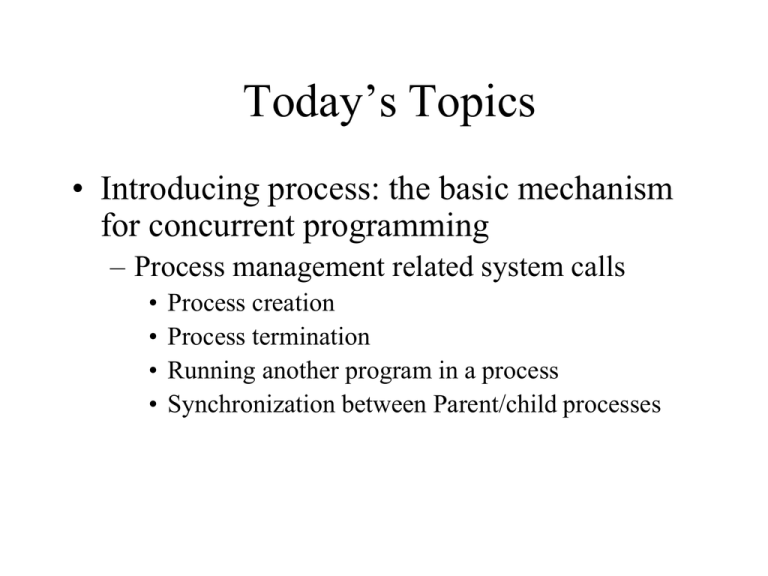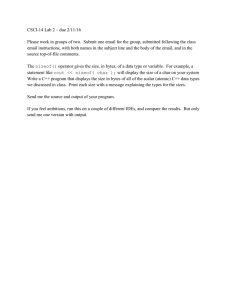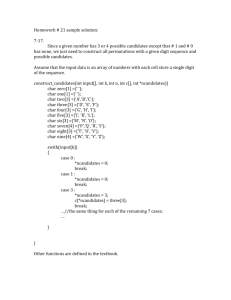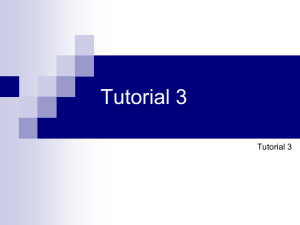Today’s Topics • Introducing process: the basic mechanism for concurrent programming
advertisement

Today’s Topics
• Introducing process: the basic mechanism
for concurrent programming
– Process management related system calls
•
•
•
•
Process creation
Process termination
Running another program in a process
Synchronization between Parent/child processes
Computer systems Overview
Processes
User
Space
System Call Interface
OS
CPU
Memory File system Device
scheduling Mgmt
Mgmt
Network Stack
HW
CPU
Memory
Disk
Keyboard
Monitor
Computer systems user’s view
Program1
Program2
ProgramX
CPU
Memory
CPU
Memory
CPU
Memory
Disk
Keyboard
Monitor
Disk
Keyboard
Monitor
Disk
Keyboard
Monitor
Each program owns its own (virtual) computer.
The execution of a program does not affect one
another.
Process
• Informal definition:
A process is a program in execution.
• Process is not the same as a program.
– Program is a passive entity stored in disk
– Program (code) is just one part of the process.
What else in a process?
• Process context – everything needed to run
resume execution of a program:
–
–
–
–
Memory space (static, dynamic)
Procedure call stack
Open files, connections
Registers and counters :
• Program counter, Stack pointer, General purpose
registers
– ……
Why process?
• Multiple processes (users) share the system
resources.
• Multiple processes run independently
• Which of the following is more important?
– Process isolation (the illusion that each process is
the only one on the machine).
– Process interaction (synchronization, inter-process
communication).
Examining Processes in Unix
• ps command
– Standard process attributes
• /proc directory
– More interesting information.
– Try “man proc”
• Top, vmstat command
– Examining CPU and memory usage statistics.
Creating a New Process - fork()
pid = fork();
if (pid == -1) {
fprintf(stderr, "fork failed\n");
exit(1);
}
if (pid == 0) {
printf(“This is the child\n");
exit(0);
}
if (pid > 0) {
printf(“This is parent. The child is %d\n", pid);
exit(0);
}
Points to Note
• fork() is called once …
• … but it returns twice!!
– Once in the parent and
– Once in the child
– See example1.c
• Fork() basically duplicates the parent process image
– Both processes are exactly the same after the fork()
call.
• Are there any dependence between the two processes?
– Provide a way to distinguish the parent and the
child.
Points to Note
• How to distinguish parent and child??
– Return value in child = 0
– Return value in parent = process id of child
– See example2.c
• What about the data in the program?
– See example6.c.
• Return value of -1 indicates error in all UNIX
system calls – another UNIX convention
• Is it true: All processes are created by fork() in
UNIX?
Running an existing command in
a program – exec()
• int execl(char * pathname, char * arg0, … , (char
*)0);
• int execv(char * pathname, char * argv[]);
• int execle(char * pathname, char * arg0, … , (char
*)0, char envp[]);
• int execve(char * pathname, char * argv[], char
envp[]);
• int execlp(char * filename, char * arg0, … , (char
*)0);
• int execvp(char * filename, char * argv[]);
execv
• int execv(char * pathname,
char * argv[]);
Example: to run “/bin/ls –l –a /”
pathname: file path for the executable
char *argv[]: must be exactly the same as the
C/C++ command line argument. E.g argv[4]
must be NULL.
See example3d.c
Examples
• Running one command example3a.c
– Run command with any parameters?
• Run all commands in the comand line
argument – example3b.c?
Properties of exec()
• Replaces current process image with new program
image.
– E.g. parent image replaced by the new program image.
– If successful, everything after the exec() call will NOT
be executed.
• Will execv() return anything other than -1?
Running a command without killing the
process
Running a command without killing the
process
Parent
Running a command without killing the
process?
Parent
Fork(…)
Child
Running a command without killing the
process, see example3.c, fixing example3b.c
Parent
Fork(…)
Child
Exec(…)
New program
image
in execution
Terminating a process
• exit (int status)
– Clean up the process (e.g close all files)
– Tell its parent processes that he is dying
(SIGCHLD)
– Tell child processes that he is dying (SIGHUP)
– Exit status can be accessed by the parent process.
• When a process exits – not all resources
associated with the process are freed yet!!
– ps can still see the process (<defunct>), see
example6.c
Parent/child synchronization
• Parent created the child, he has the
responsibility to see it through:
– check if the child is done.
• wait, waitpid
– This will clean up all trace of the child process from the
system. See example6.c
– check if the exit status of the child
• pid_t wait(int *stat_loc), see example4.c
– Some others such as whether the child was killed
by an signal. etc
• A child has no responsibility for the parent
– Processes are identified by a process id (pid)
• getpid(): find your own pid
• getppid(): find the pid of the parent
– See example5.c for the time for system calls
versus regular routine calls.
– A question: How to implement the system
routine?
Review
•
•
•
•
•
•
•
•
•
•
Why processes?
What is process context?
How to check processes in UNIX?
What does fork() do? What is its return value?
Does fork() create all processes in a UNIX system?
What does execv() do? What is its return value?
How to run a command in a program without getting killed?
Does exit completely clean up a process?
Can a parent process tell if its child process terminate normally?
Can a child process tell if its parent process terminate normally?






